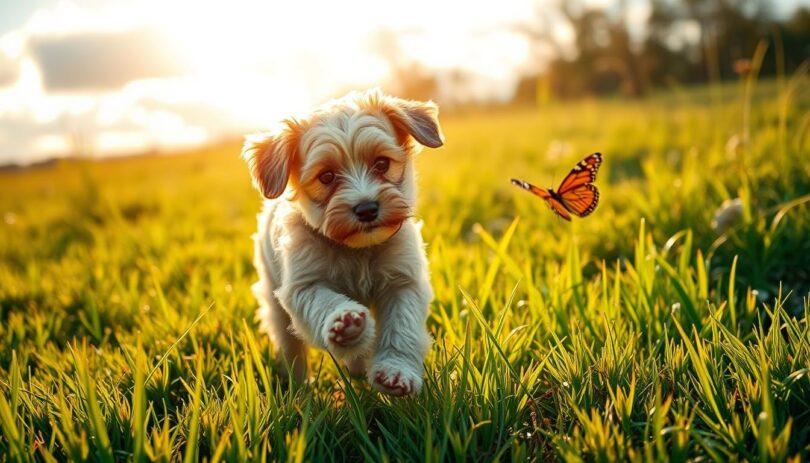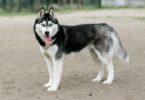Imagine coming home to a loyal friend whose playful energy brightens your day. Picture a companion whose intelligence makes training feel effortless and whose affection strengthens your family bond. This is the reality for many owners of the Schnauzer Poodle mix—a hybrid breed that blends the best qualities of two beloved parent lines.
These dogs thrive in households seeking adaptable pets. Their sharp minds and eagerness to please make them quick learners, while their low-shedding coats appeal to allergy-conscious families. Though no breed is fully hypoallergenic, many find this cross fits seamlessly into their lifestyles.
Puppies often showcase traits from both lineages early—curious Poodle-like problem-solving paired with the Schnauzer’s alert confidence. Whether you’re drawn to their expressive eyes or their reputation as versatile family dogs, this hybrid offers a compelling mix of charm and practicality.
From city apartments to suburban homes, these companions adapt while maintaining their spirited personalities. As we explore their care needs and characteristics in later sections, consider: Could this be the four-legged partner you’ve been searching for?
Overview of the Schnauzer Poodle Mix Breed
Originating in the 1980s, this crossbreed combines two iconic parent breeds known for intelligence and loyalty. Breeders aimed to create adaptable companions suitable for diverse households while minimizing shedding. Their success lies in merging distinct traits from both lineages into one dynamic hybrid.
Heritage and Origins
The Schnauzer brings alert confidence honed through centuries as farm guardians in Germany. Poodles contribute problem-solving skills refined during their history as water retrievers. When crossed, these breeds produce dogs with keen instincts and trainable personalities.
What Sets This Breed Apart
Three factors distinguish this hybrid from other designer breeds. First, size variations from toy to standard allow matching owners’ lifestyles. Miniature versions often inherit the Poodle’s compact build with the Schnauzer’s sturdy frame. Second, genetic diversity from both parents reduces breed-specific health risks. Finally, their coats combine low-shedding textures with allergy-friendly qualities.
Puppies frequently showcase early signs of inherited traits like curiosity and adaptability. Whether from toy or standard parents, these dogs maintain a consistent reputation as attentive family members. Their balanced temperament reflects careful pairing of complementary breed histories.
Physical Characteristics and Size Variations
This hybrid’s appearance showcases a blend of features that make each dog distinct. From soft curls to wiry textures, their coats adapt to different climates while minimizing shedding. These adaptable traits make them ideal for owners prioritizing both aesthetics and practicality.
Coat Texture and Color Options
Their fur often combines the Poodle’s loose curls with the Schnauzer’s coarser guard hairs. Common textures range from wavy to tightly coiled, requiring regular brushing to prevent matting. Colors vary widely—solid black, salt-and-pepper, or even apricot shades appear in litters.
Proper coat maintenance supports skin health and reduces allergens. For detailed grooming strategies, explore our guide to coat care.
Measurements and Build
Size depends largely on parent breeds. Miniature versions stand 12–15 inches tall, while those from standard lines reach 19–23 inches. Weight ranges from 15 pounds for smaller dogs to 50 pounds for larger builds.
Their sturdy frames balance athleticism with compact proportions. Some inherit the Schnauzer’s square profile, while others display the Poodle’s leaner silhouette. This diversity ensures every owner finds a companion matching their lifestyle.
Temperament and Personality Traits
A dog’s personality shapes every family interaction. The Schnoodle thrives as a loyal companion, blending sharp intuition with joyful enthusiasm. These dogs form deep bonds, often shadowing their favorite humans from room to room. Their affectionate nature makes them excellent emotional support animals.
Loyal and Energetic Nature
This breed’s loyalty stems from its guardian heritage. Many dogs alert owners to strangers while maintaining a friendly demeanor. Daily play sessions are essential—their high energy demands activities like fetch or puzzle games. Without engagement, they may invent their own entertainment.
Family-Friendly Behavior
Families appreciate how these dogs adapt to different dynamics. They interact gently with kids, often tolerating clumsy hugs during playtime. One parent breed contributes a protective streak, making them watchful yet non-aggressive companions.
Calm moments balance their playful bursts. After exercise, they’ll curl up beside you, content to simply be present. Their responsiveness to training shines when teaching tricks or house rules. For those raising a well-adjusted pet, consistency yields impressive results.
Does this blend of devotion and vitality suit your household? These dogs flourish where they’re included in daily life, whether through walks or cozy evenings at home.
Health Considerations for the Schnauzer Poodle Mix
Maintaining your dog’s well-being starts with understanding potential health risks. While generally robust, these pets may inherit conditions from their parent breeds. Proactive care helps ensure they live full, active lives.
Common Health Issues
Joint dysplasia ranks among the most frequent concerns, particularly in larger dogs. Hereditary conditions like diabetes and epilepsy also appear in some lines. Puppies benefit from early screenings to detect issues before symptoms emerge.
Watch for signs like limping, excessive thirst, or sudden fatigue in young dogs. Ear infections can develop if moisture gets trapped in their folded ears. Regular inspections during grooming sessions help catch problems early.
Preventative Care and Management
Routine veterinary visits form the foundation of effective care. Schedule annual check-ups and bloodwork to monitor organ function. Balanced exercise prevents obesity—a key factor in joint health.
Owners should brush their dog’s teeth weekly and trim nails monthly. For puppies, establish vaccination schedules and parasite prevention early. These steps significantly reduce long-term health risks while strengthening your bond through consistent care.
Training Tips and Behavioral Insights
Effective training transforms a playful pup into a well-mannered companion. These intelligent dogs thrive on structure and positive interactions, making consistency the cornerstone of success. Start with short sessions to keep their focus sharp and end each practice on a high note.
Positive Reinforcement Techniques
Reward-based methods yield the best results. Use treats, praise, or toys immediately after desired behaviors like sitting or staying. Clicker training works exceptionally well for teaching tricks like “shake” or “roll over.”
Avoid scolding—redirect unwanted actions calmly. For example, swap chewing shoes with a designated toy. Trainers recommend five-minute sessions three times a day to prevent burnout while reinforcing lessons.
Socialization and Daily Routine
Expose puppies to diverse environments early. Introduce them to new people, sounds, and surfaces before 16 weeks. This builds confidence and reduces anxiety during vet visits or trips.
Establish a predictable day structure. Morning walks, afternoon training time, and evening play create stability. Make sure to allocate 10-15 minutes daily for command practice. Pair meals with obedience drills to reinforce good habits.
A well-socialized dog adapts smoothly to changes in routine. Consistency in training and exposure helps them become adaptable, joyful companions for years.
Feeding Guidelines and Nutritional Needs
Proper nutrition forms the foundation of your dog’s health and vitality. Tailoring meals to their unique needs supports energy levels, coat quality, and long-term wellness. Start by evaluating your pet’s life stage and body type—factors that directly influence dietary requirements.
Meal Planning by Size and Age
Puppies need frequent meals with higher protein content—aim for three servings daily. Small adults (under 20 lbs) typically require 400-550 calories, while larger dogs may need 900+ calories. Dogs with standard poodle heritage often benefit from joint-supporting nutrients like glucosamine.
Adjust portions as your pet ages. Senior dogs usually need 20% fewer calories than active adults. Use a measuring cup for accuracy and consult your vet for personalized plans.
Choosing High-Quality Dog Food
Prioritize AAFCO-approved formulas that list real meat as the first ingredient. Avoid fillers like corn and soy—these offer limited nutritional value. For dogs prone to allergies, consider limited-ingredient diets.
High-quality dog food often includes omega fatty acids for skin health and probiotics for digestion. If your pet inherits the standard poodle’s active metabolism, look for formulas with balanced carbs and proteins. Always make sure fresh water is available throughout the day.
Grooming and Maintenance Essentials
A well-groomed dog reflects both care and commitment. These companions require consistent routines to maintain their signature appearance and health. Proper techniques prevent skin issues while keeping their coats soft and manageable.
At-Home Grooming Tips
Brush their coat three times weekly using a slicker brush. This prevents tangles in wavy textures and distributes natural oils. Trim nails every 3-4 weeks to avoid overgrowth that affects posture.
Clean ears weekly with vet-approved solution. Moisture-prone folds need gentle wiping to prevent infections. Use rounded scissors for face trimming, avoiding sensitive areas.
When to Visit a Professional Groomer
Schedule professional sessions every 6-8 weeks for complex trims or matted fur. Groomers handle challenging tasks like paw pad shaving and sanitary cuts safely. They also spot early skin issues owners might miss.
Puppies benefit from introductory salon visits. Early positive experiences help them tolerate grooming throughout adulthood. Teach young dogs to accept handling through short daily touch exercises.
Combining home care with expert help keeps schnoodles looking sharp. Regular maintenance becomes bonding time that strengthens your relationship while meeting their grooming needs.
Exercise, Play, and Mental Stimulation for Schnoodles
Keeping your companion active isn’t just about physical health—it’s the key to unlocking their full potential. These energetic dogs thrive when their days blend structured movement with creative challenges. A balanced routine prevents boredom while strengthening your bond through shared activities.
Daily Movement Essentials
Two 20-minute walks per day maintain muscle tone and mental sharpness. Vary routes to expose your dog to new smells and sights. For small dogs, shorten distances but increase frequency—three shorter strolls work better than one long trek.
Interactive play sessions count as exercise too. Tug-of-war builds strength, while fetch exercises their natural retrieval instincts. Always match intensity to your pet’s size—opt for softer toys with compact companions.
Brain-Boosting Activities
Rotate puzzle toys weekly to keep minds engaged. Stuff rubber Kongs with peanut butter for rewarding challenges. Hide treats around rooms to spark their inner detective during “find it” games.
Incorporate training into playtime. Practice “stay” during fetch throws or “leave it” with tempting toys. Fifteen minutes of daily command practice reinforces obedience while burning mental energy.
Remember: Schnoodles live their best lives when given varied stimulation. Mix up activities each day to maintain excitement. Whether you have a compact companion or larger athlete, adapting games ensures every dog stays happily occupied.
Final Thoughts: Celebrating Your Unique Schnoodle Companion
Every dog brings its own spark to family life, but schnoodles offer something truly special. These clever companions blend the best qualities of their heritage—curiosity meets loyalty, playfulness pairs with intuition. Whether your home suits compact pups or larger athletes, their adaptable nature shines through.
Size variations let you choose a perfect match. Miniature versions fit cozy spaces, while those with giant schnauzer lineage thrive in active households. All sizes share a knack for bonding with kids and other pets, making them natural family unifiers.
Daily life with a schnoodle means shared adventures and quiet moments. Their intelligence demands engaging games, while their affectionate side rewards consistent care. Remember: proper training and grooming ensure they remain joyful partners for years.
Celebrate the unique charm these puppies bring. From spirited play to comforting snuggles, they enrich every day. By committing to their needs, you’ll gain more than a pet—you’ll discover a devoted friend who makes life brighter.
FAQ
How big do Schnoodles get?
Size varies based on parent breeds—toy poodle mixes stay under 12 pounds, while standard schnauzer crosses can reach 50–60 pounds. Miniature versions typically weigh 15–25 pounds. Always ask breeders about the parents’ sizes for clarity.
Are these dogs hypoallergenic?
Their low-shedding coats (inherited from poodles) reduce allergens, but no dog is fully hypoallergenic. Regular brushing and baths help minimize dander. Families with allergies should spend time with the breed before adopting.
What type of diet works best?
High-quality kibble like Royal Canin or Hill’s Science Diet suits most Schnoodles. Adjust portions based on activity level—miniature mixes may need ¾–1 cup daily, while larger ones require up to 2 cups. Consult your vet for age-specific needs.
How often do they need grooming?
Brush wiry or curly coats 3–4 times weekly to prevent mats. Professional trims every 6–8 weeks maintain shape. Check ears weekly for debris to avoid infections, especially in floppy-eared pups.










Leave a Comment